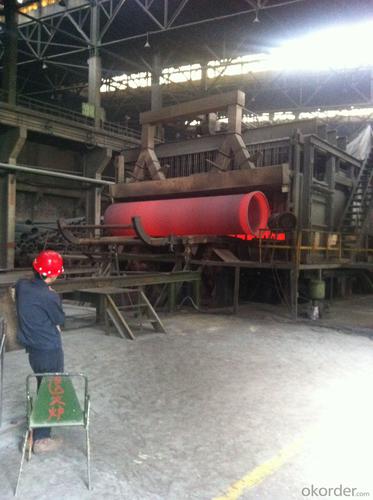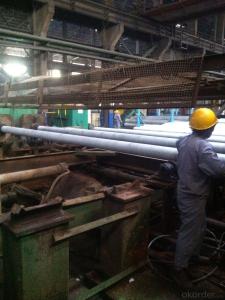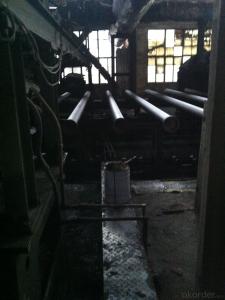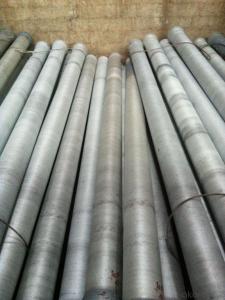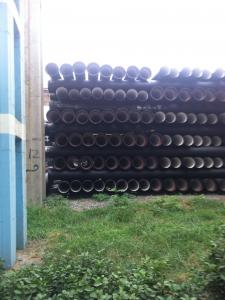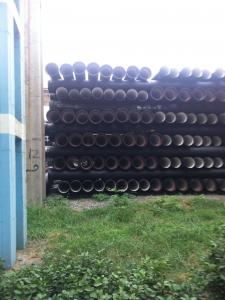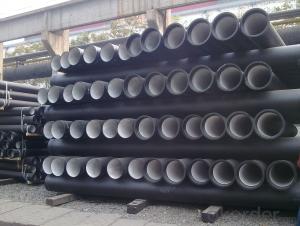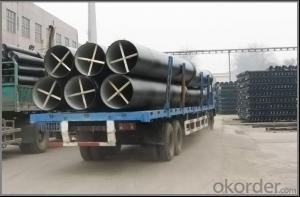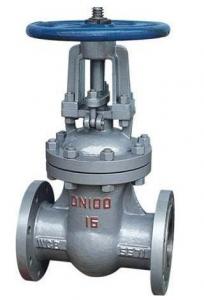DUCTILE IRON PIPES AND PIPE FITTINGS K9 CLASS DN900
- Loading Port:
- Tianjin
- Payment Terms:
- TT OR LC
- Min Order Qty:
- 22 pc
- Supply Capability:
- 3000 pc/month
OKorder Service Pledge
OKorder Financial Service
You Might Also Like
Material : Ductile Cast Iron
Size Range : DN 80mm to DN 2000mm
Unit Effective Length : 6m or 5.7m
Manufacture Standard: ISO 2531:1998/ EN 545:2006/EN 598:2007
Annual capacity : 200,000 tons
Coating Exterior: Zinc 130g/m2 according to ISO 8179-1 and bitumen coating 70 microns.
Cement Interior: Portland Cement/ High Alumina Cement/ Sulphate Resisting Cement Lining according to ISO 4179
Special requirements on external coating and internal lining can be applied
We also provide accessories such as SBR/EPDM rubber gaskets, lubricant paste, pipe caps, PE sleeves, etc.
Additional Parts:
Each pipe is strictly inspected according to related standard to ensure permanently high performance.
Easy Installation at site and service free for life
Long Service Lifespan
Quotation will arrive you within 24hours once we get your inquiry.
We guarantee offering you a competitive price.
A copy of original inspection reports of pipes will be offered after shipment.
Photos of loading process will be sent to the customer after shipment effect.
We will follow-up the delivery progress after shipment effect and update to the customer on weekly basis.
- Q: The difference between cast iron pipe and ductile iron pipe
- Cast iron pipes, also known as pig iron pipes, ordinary gray iron. Often used in socket connection, the sealing material is usually cement rigid interface.
- Q: Is the fire hose capable of using rapid repair joints?
- Installation joint. Insert the socket into the socket to coincide with the central axis of the pipe or pipe to be joined. Use a guide chain to tighten the pipe member until the pipe mouth enters between the two white lines.
- Q: How does ductile iron pipe handle traffic loads and vibrations?
- Ductile iron pipe is well-equipped to handle traffic loads and vibrations due to its inherent strength and durability. The material properties of ductile iron, such as its high tensile strength and impact resistance, make it a reliable choice for withstanding heavy loads and vibrations caused by traffic. When subjected to traffic loads, ductile iron pipe has the ability to distribute the weight effectively, minimizing stress concentrations and potential damage. This is due to its flexible nature, which allows it to absorb and dissipate the forces exerted by traffic, preventing cracks or fractures from forming. Moreover, ductile iron pipe's ability to dampen vibrations is another advantage. Its high density and stiffness help to absorb and dissipate the energy generated by vibrations, reducing their impact on the pipe and surrounding infrastructure. This is crucial in areas with heavy traffic or construction activities, where vibrations can be common. Furthermore, ductile iron pipes are often designed and manufactured to meet industry standards and specifications, ensuring they can withstand the anticipated traffic loads and vibrations. These pipes are commonly used in water distribution systems, sewers, and underground infrastructure, where they are subjected to various dynamic loads and vibrations. In summary, ductile iron pipe is an excellent choice for handling traffic loads and vibrations due to its strength, flexibility, and ability to dampen vibrations. Its reliable performance under these conditions makes it a preferred material for infrastructure projects, ensuring long-term durability and minimal impact on the pipe's structural integrity.
- Q: What are the disadvantages of using ductile iron pipe?
- There are several disadvantages associated with using ductile iron pipe. Firstly, one major drawback is its cost. Ductile iron pipe tends to be more expensive than other types of piping materials such as PVC or even traditional cast iron. This can make it less appealing for projects with strict budget constraints. Secondly, ductile iron pipe is relatively heavy compared to other materials. This makes it more difficult to handle and install, requiring specialized equipment and additional labor. The weight can also make it more susceptible to damage during transport and installation. Another disadvantage is its susceptibility to corrosion. While ductile iron is more resistant to corrosion than traditional cast iron, it is still prone to rust and deterioration over time. This can lead to reduced lifespan and potential leaks or pipe failures. Additionally, ductile iron pipe has limited flexibility and is not as resistant to ground movement or settlement. This can result in cracking or breaking of the pipe, especially in areas with unstable soil conditions or seismic activity. Lastly, ductile iron pipe can have a rough interior surface, which can lead to increased friction and reduced flow capacity. This can result in higher pumping costs and decreased efficiency in fluid transportation. Overall, while ductile iron pipe has its advantages, such as its strength and durability, these disadvantages should be carefully considered when choosing the appropriate piping material for a specific project.
- Q: What is the expected surge pressure rating of ductile iron pipes?
- The surge pressure rating for ductile iron pipes can vary based on several factors, including pipe diameter, thickness, joint type, and manufacturer specifications. Generally, ductile iron pipes are built to withstand surge pressures ranging from 150% to 200% of their working pressure rating. For instance, if a ductile iron pipe has a working pressure rating of 250 psi, it can typically handle surge pressures of 375 psi to 500 psi. To obtain accurate surge pressure ratings for the specific ductile iron pipes being used, it is crucial to refer to the manufacturer's specifications and guidelines.
- Q: Are ductile iron pipes resistant to abrasion or wear?
- Yes, ductile iron pipes are highly resistant to abrasion or wear due to their inherent strength and durability.
- Q: Can ductile iron pipes be repaired if they get damaged?
- Yes, ductile iron pipes can be repaired if they get damaged. The repair process typically involves cutting out the damaged section and replacing it with a new pipe segment or using repair clamps to fix minor leaks or cracks.
- Q: Can ductile iron pipe be used for underground applications?
- Yes, ductile iron pipe can be used for underground applications.
- Q: Can ductile iron pipes be used in areas with high levels of groundwater contamination?
- Areas with high levels of groundwater contamination can make use of ductile iron pipes. Ductile iron, known for its strength and durability, is resistant to corrosion, making it suitable for various environments, including those with contaminated groundwater. It provides a high level of resistance to chemicals and can withstand the corrosive effects of contaminants that may be present in the groundwater. Furthermore, ductile iron pipes possess a protective lining, further enhancing their corrosion resistance. However, it is important to consider that the suitability of ductile iron pipes in such areas relies on the specific nature and concentration of contaminants in the groundwater. Seeking advice from experts and adhering to local regulations and industry standards is essential to ensure the proper selection and installation of pipes in areas with high levels of groundwater contamination.
- Q: What are the typical joint restraint systems used in ductile iron pipes?
- The typical joint restraint systems used in ductile iron pipes are mechanical joint restraints, push-on joint restraints, and restrained joint systems. These systems are designed to prevent pipe separation and movement at the joints, ensuring the integrity and stability of the pipeline.
Send your message to us
DUCTILE IRON PIPES AND PIPE FITTINGS K9 CLASS DN900
- Loading Port:
- Tianjin
- Payment Terms:
- TT OR LC
- Min Order Qty:
- 22 pc
- Supply Capability:
- 3000 pc/month
OKorder Service Pledge
OKorder Financial Service
Similar products
Hot products
Hot Searches
Related keywords

